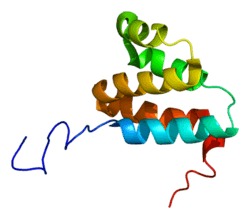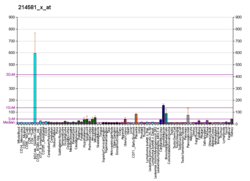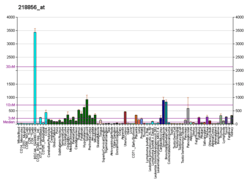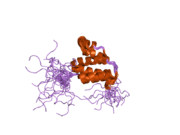Death receptor 6
Death receptor 6 (DR6), also known as tumor necrosis factor receptor superfamily member 21 (TNFRSF21), is a cell surface receptor of the tumor necrosis factor receptor superfamily which activates the JNK and NF-κB pathways.[5][6] It is mostly expressed in the thymus, spleen and white blood cells.[7] The Gene for DR6 is 78,450 bases long and is found on the 6th chromosome. This is transcribed into a 655 amino acid chain weighing 71.8 kDa. Post transcriptional modifications of this protein include glycosylation on the asparagines at the 82, 141, 252, 257, 278, and 289 amino acid locations.[8]
Function
The protein encoded by this gene is a member of the TNF-receptor superfamily. This receptor has been shown to activate NF-κB and MAPK8/JNK, and induce cell apoptosis. Through its death domain, this receptor interacts with TRADD protein, which is known to serve as an adaptor that mediates signal transduction of TNF-receptors. Knockout studies in mice suggested that this gene plays a role in T helper cell activation, and may be involved in inflammation and immune regulation.[6] The DR6 is an alpha-helical integral membrane receptor protein that shows evidence that it has something to do with the inhibition of blood vessels forming on tumors which would allow them to grow larger. Death receptor 6 gets a chemical message and starts a signaling pathway that causes apoptosis, also known as cell death, to occur.[9] It is also expressed in endothelial cells. Tumor cells can induce, through exposition of amyloid precursor protein (APP), DR6-mediated endothelial cell necroptosis allowing tumors metastasis.
Clinical significance
The free serum levels of this DR6 are heightened with anti-cell death factors in patients that have later stage ovarian cancer.[10]
DR6 is also thought to be involved in neurodegeneration in the brain that causes Alzheimer's disease as well as signal transduction in stress response and cellular survival.[11] DR6 induces apoptosis when it is over expressed, however the manner in which the death signal is intracellularly transduced is currently unknown. It has been determined that Bax translocation is necessary for the apoptosis triggered by DR6, but through an unknown pathway instead of the traditional pathways of intrinsic versus extrinsic. APP (amyloid precursor protein) is the natural ligand of DR6 and is first cleaved into Aβ and N-APP. N-APP is the fragment that interacts with DR6 to trigger axonal degradation in Alzheimer's patients.[12] This pathway is essentially "hi-jacked" in the aging brain.
References
- GRCh38: Ensembl release 89: ENSG00000146072 - Ensembl, May 2017
- GRCm38: Ensembl release 89: ENSMUSG00000023915 - Ensembl, May 2017
- "Human PubMed Reference:". National Center for Biotechnology Information, U.S. National Library of Medicine.
- "Mouse PubMed Reference:". National Center for Biotechnology Information, U.S. National Library of Medicine.
- Pan G, Bauer JH, Haridas V, Wang S, Liu D, Yu G, Vincenz C, Aggarwal BB, Ni J, Dixit VM (July 1998). "Identification and functional characterization of DR6, a novel death domain-containing TNF receptor" (PDF). FEBS Letters. 431 (3): 351–6. doi:10.1016/S0014-5793(98)00791-1. PMID 9714541.
- "Entrez Gene: TNFRSF21 tumor necrosis factor receptor superfamily, member 21".
- Salido, Ginés María; Rosado, Juan Antonio (2009). Apoptosis: Involvement of Oxidative Stress and Intracellular Ca2+ Homeostasis. Heidelberg, Germany: Springer. p. 37. ISBN 9781402098734.
- Mungall AJ, Palmer SA, Sims SK, Edwards CA, Ashurst JL, Wilming L, et al. (October 2003). "The DNA sequence and analysis of human chromosome 6". Nature. 425 (6960): 805–11. doi:10.1038/nature02055. PMID 14574404.
- Daniel PT, Wieder T, Sturm I, Schulze-Osthoff K (2001). "The kiss of death: promises and failures of death receptors and ligands in cancer therapy". Leukemia. 15 (7): 1022–32. doi:10.1038/sj.leu.2402169. PMID 11455969.
- Sasaroli D, Gimotty PA, Pathak HB, Hammond R, Kougioumtzidou E, Katsaros D, Buckanovich R, Devarajan K, Sandaltzopoulos R, Godwin AK, Scholler N, Coukos G (2011). "Novel surface targets and serum biomarkers from the ovarian cancer vasculature". Cancer Biology & Therapy. 12 (3): 169–80. doi:10.4161/cbt.12.3.16260. PMC 3230481. PMID 21617380.
- Kuester M, Kemmerzehl S, Dahms SO, Roeser D, Than ME (June 2011). "The crystal structure of death receptor 6 (DR6): a potential receptor of the amyloid precursor protein (APP)". Journal of Molecular Biology. 409 (2): 189–201. doi:10.1016/j.jmb.2011.03.048. PMID 21463639.
- Osherovich L (2009). "Genentech's new parADigm". Science-Business EXchange. 2 (8): 1–5. doi:10.1038/scibx.2009.300.
Further reading
- Pan G, Bauer JH, Haridas V, Wang S, Liu D, Yu G, Vincenz C, Aggarwal BB, Ni J, Dixit VM (July 1998). "Identification and functional characterization of DR6, a novel death domain-containing TNF receptor" (PDF). FEBS Letters. 431 (3): 351–6. doi:10.1016/S0014-5793(98)00791-1. PMID 9714541.
- Liu J, Na S, Glasebrook A, Fox N, Solenberg PJ, Zhang Q, Song HY, Yang DD (July 2001). "Enhanced CD4+ T cell proliferation and Th2 cytokine production in DR6-deficient mice". Immunity. 15 (1): 23–34. doi:10.1016/S1074-7613(01)00162-5. PMID 11485735.
- Zhao H, Yan M, Wang H, Erickson S, Grewal IS, Dixit VM (November 2001). "Impaired c-Jun amino terminal kinase activity and T cell differentiation in death receptor 6-deficient mice". The Journal of Experimental Medicine. 194 (10): 1441–8. doi:10.1084/jem.194.10.1441. PMC 2193683. PMID 11714751.
- Kasof GM, Lu JJ, Liu D, Speer B, Mongan KN, Gomes BC, Lorenzi MV (November 2001). "Tumor necrosis factor-alpha induces the expression of DR6, a member of the TNF receptor family, through activation of NF-kappaB". Oncogene. 20 (55): 7965–75. doi:10.1038/sj.onc.1204985. PMID 11753679.
- Mai T, Wang X, Zhang Z, Xin D, Na Y, Guo Y (October 2004). "Androgen receptor coregulator ARA267-alpha interacts with death receptor-6 revealed by the yeast two-hybrid". Science in China Series C: Life Sciences. 47 (5): 442–8. doi:10.1360/03yc0214. PMID 15623156.
- Klíma M, Zájedová J, Doubravská L, Andera L (October 2009). "Functional analysis of the posttranslational modifications of the death receptor 6". Biochimica et Biophysica Acta (BBA) - Molecular Cell Research. 1793 (10): 1579–87. doi:10.1016/j.bbamcr.2009.07.008. PMID 19654028.
This article incorporates text from the United States National Library of Medicine, which is in the public domain.







